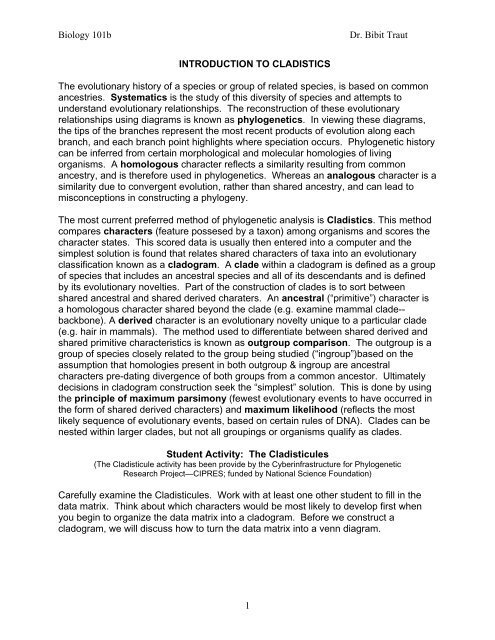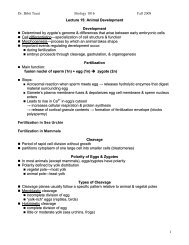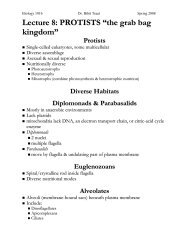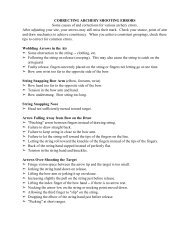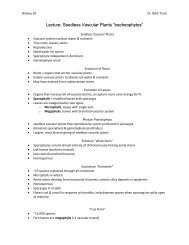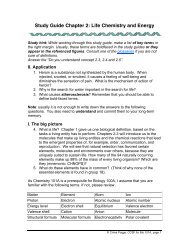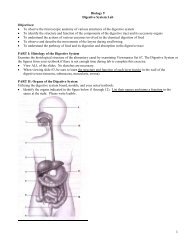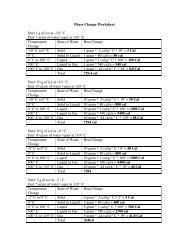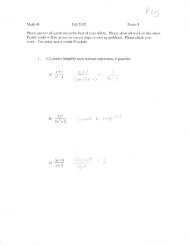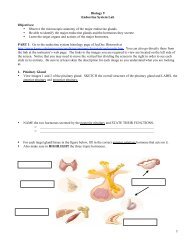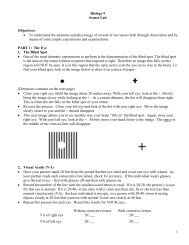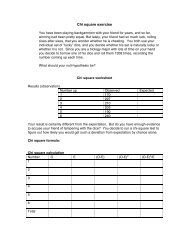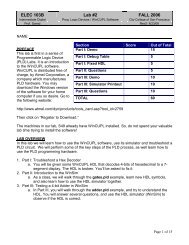INTRODUCTION TO CLADISTICS - Fog.ccsf.edu
INTRODUCTION TO CLADISTICS - Fog.ccsf.edu
INTRODUCTION TO CLADISTICS - Fog.ccsf.edu
You also want an ePaper? Increase the reach of your titles
YUMPU automatically turns print PDFs into web optimized ePapers that Google loves.
Biology 101b<br />
Dr. Bibit Traut<br />
<strong>INTRODUCTION</strong> <strong>TO</strong> <strong>CLADISTICS</strong><br />
The evolutionary history of a species or group of related species, is based on common<br />
ancestries. Systematics is the study of this diversity of species and attempts to<br />
understand evolutionary relationships. The reconstruction of these evolutionary<br />
relationships using diagrams is known as phylogenetics. In viewing these diagrams,<br />
the tips of the branches represent the most recent products of evolution along each<br />
branch, and each branch point highlights where speciation occurs. Phylogenetic history<br />
can be inferred from certain morphological and molecular homologies of living<br />
organisms. A homologous character reflects a similarity resulting from common<br />
ancestry, and is therefore used in phylogenetics. Whereas an analogous character is a<br />
similarity due to convergent evolution, rather than shared ancestry, and can lead to<br />
misconceptions in constructing a phylogeny.<br />
The most current preferred method of phylogenetic analysis is Cladistics. This method<br />
compares characters (feature possesed by a taxon) among organisms and scores the<br />
character states. This scored data is usually then entered into a computer and the<br />
simplest solution is found that relates shared characters of taxa into an evolutionary<br />
classification known as a cladogram. A clade within a cladogram is defined as a group<br />
of species that includes an ancestral species and all of its descendants and is defined<br />
by its evolutionary novelties. Part of the construction of clades is to sort between<br />
shared ancestral and shared derived charaters. An ancestral (“primitive”) character is<br />
a homologous character shared beyond the clade (e.g. examine mammal clade--<br />
backbone). A derived character is an evolutionary novelty unique to a particular clade<br />
(e.g. hair in mammals). The method used to differentiate between shared derived and<br />
shared primitive characteristics is known as outgroup comparison. The outgroup is a<br />
group of species closely related to the group being studied (“ingroup”)based on the<br />
assumption that homologies present in both outgroup & ingroup are ancestral<br />
characters pre-dating divergence of both groups from a common ancestor. Ultimately<br />
decisions in cladogram construction seek the “simplest” solution. This is done by using<br />
the principle of maximum parsimony (fewest evolutionary events to have occurred in<br />
the form of shared derived characters) and maximum likelihood (reflects the most<br />
likely sequence of evolutionary events, based on certain rules of DNA). Clades can be<br />
nested within larger clades, but not all groupings or organisms qualify as clades.<br />
Student Activity: The Cladisticules<br />
(The Cladisticule activity has been provide by the Cyberinfrastructure for Phylogenetic<br />
Research Project—CIPRES; funded by National Science Foundation)<br />
Carefully examine the Cladisticules. Work with at least one other student to fill in the<br />
data matrix. Think about which characters would be most likely to develop first when<br />
you begin to organize the data matrix into a cladogram. Before we construct a<br />
cladogram, we will discuss how to turn the data matrix into a venn diagram.<br />
1
Biology 101b<br />
Dr. Bibit Traut<br />
2
Biology 101b<br />
Dr. Bibit Traut<br />
Anatomy of a Cladisticule<br />
3
Phylogenetic Analysis of the Cladisticules – Data Matrix<br />
1 2 3 4 5 6 7<br />
head fused to thorax<br />
yes (0) no<br />
(1)<br />
feet two<br />
toes (0)<br />
three toes<br />
(1)<br />
numebr of legs<br />
four (0) six<br />
(1)<br />
antennae absent<br />
(0) present (1)<br />
horns absent<br />
(0)<br />
present (1)<br />
thorax<br />
white (0)<br />
hour glass (1)<br />
abdomen<br />
white (0)<br />
black (1)<br />
Joe (OG)<br />
April<br />
Mike<br />
Tanya<br />
Bobby<br />
Jason<br />
Jerry<br />
Jane<br />
Assignment:<br />
1. For cladisticules: Fill in matrix, use this to draw Venn diagram, and create a cladogram.<br />
2. Complete cladistics activity for plants.<br />
4


